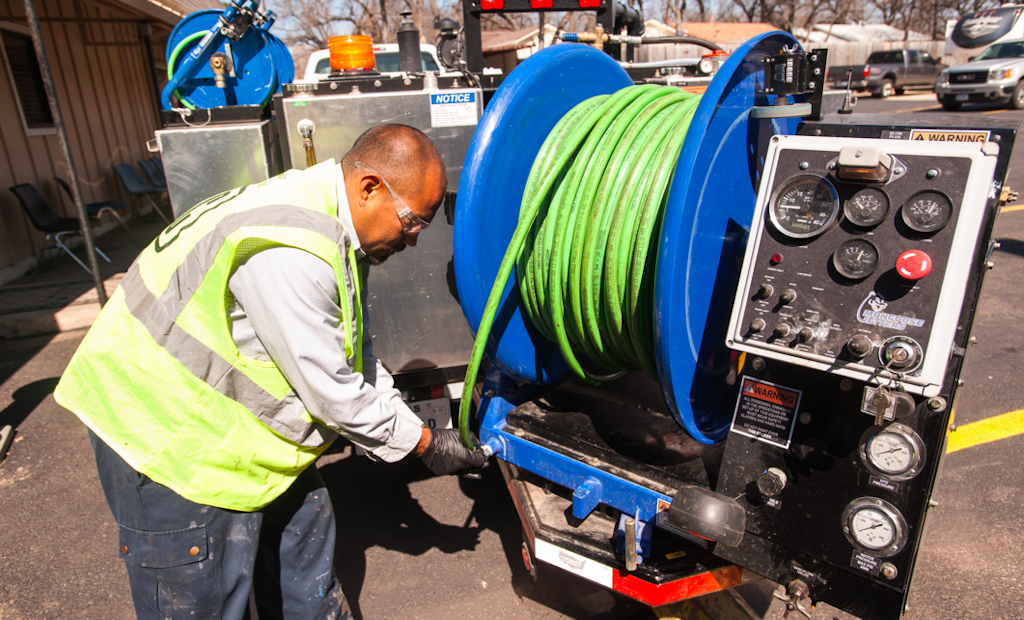
Interested in Business?
Get Business articles, news and videos right in your inbox! Sign up now.
Business + Get AlertsYou’re probably familiar with water jetters, even if you don’t own or operate them. Jetters provide a powerful sewer and drain cleaning option, but they’re not all the same, and you need to have a good understanding of their features and functions before making a purchase.
The concept is simple: A powerful pump injects a high-pressure stream of water into a pipe via a heavy-duty hose with a nozzle on the end. Nozzles focus the water stream in specific directions to clear the line. They are designed to do everything from clearing soft blockages, such as thick grease plugs, to busting through sludge and debris and removing hardened scale buildup. In fact, a jetter can often restore the inside of pipes to almost-new condition.
Better yet, a water jetter can greatly expand your customer base, because it can clean much larger drainlines and handle blockages you couldn’t even dream about tackling before. Profitability increases, too, because you can charge a higher flat fee or hourly rate for jetting, plus a jetter can do more jobs per week, industry experts note.
“Cable machines are great — up to a certain point,” says Brian Gilbert, national sales manager for Harben, which offers a wide range of water jetters. “A cable machine will poke a hole through a clog, but it won’t clean the entire circumference of a pipe as thoroughly. It is also limited in the length of pipe it can clean.”
Start with the basics
While that all sounds great, choosing the right jetter for your operation isn’t so simple. To demystify the process, here are some basic things to consider as you weigh your options.
There are essentially two kinds of jetters available (with variations within those core categories): smaller cart-mounted units, powered by electric motors or gasoline engines (or even propane engines, in some cases) and much larger and more powerful units mounted on either trailers, trucks or skids.
The wheeled, cart-mounted units generally are best suited for clearing smaller clogs — including grease and sediment — and performing preventive maintenance cleaning in drainlines ranging from 1 1/4 to 6 inches in diameter. Generally speaking, they generate anywhere from 2,000 to 3,000 psi and flows of 2 to 4 gpm. Cost typically ranges from $2,500 to $5,000. Mobility and utility are their biggest assets, says Tim Gage, the Ohio territory manager for Spartan Tool, which makes almost two dozen different models of water jetters.
“With a cart-mounted electric jetter, you can go inside buildings like apartments or hospitals and get right to the clean-out without worrying about producing fumes,” Gage explains. “You just hook them up to a garden hose and go to work.” Moreover, some portable jetters offer detachable hose reels, which enable technicians to enter buildings without struggling to maneuver the cart down basement stairs, for instance, or enter buildings where gas engines are not allowed.
Heavier artillery
Taking on 4- to 12-inch-diameter pipelines requires larger trailer- or truck-mounted units. The main components on these units include more powerful pumps capable of producing pressure up to 4,000 psi and flow of 12 to 18 gpm; water tanks (300-gallon capacity is about average); and 500 feet of 1/2-inch-diameter hose. These jetters can also be mounted on a skid and carried in the back of a large pickup truck. Trailer jetters typically start at around $10,000, Gage says.
“A truck can carry more water than a trailer, but in some cases, a trailer can be more maneuverable than a truck,” Gilbert says, pointing out some advantages of each kind of jetter. “And skids can be configured for electric-powered jetters, which can be used in an industrial setting where gas engines are not allowed.
“Some skid units can be put on a three-wheeled tow dolly that you can move from location to location inside a building,” he says. “The unit might weigh about 700 pounds, but with casters and a steerable dolly handle, you can move it around manually.”
Other basic trailer jetter features include the following (whether these features are standard or optional varies by manufacturer):
- Safety shut-offs that automatically turn the machine off when it runs out of water or runs low on oil
- Manual or power hose rewind
- Pulse action that vibrates the hose to help it work around bends and through tough clogs
- Remote-control operation
- A pivoting and telescoping hose reel that makes it easier to align the hose with clean-outs, manholes and the like
- Weatherization kits that prevent internal systems from freezing up
- Hot-water capability for thawing drainlines and more effective cleaning of grease clogs
“I personally would want the power hose rewind, especially if you’re doing city work and stretching out 300 to 400 feet of line,” Gage says when asked which features provide the most bang for the buck. “They save you a ton of time, plus you get a smoother winding hose, and your arm isn’t worn out by the end of the day. And if you’re not as worn out, you make less mistakes. It might cost about $1,000 extra, but you have to weigh the benefits.”
Remote-control operation also enhances productivity, Gage and Gilbert note. Remote-control units can operate a trailer jetter from up to 500 feet away. They boost on-the-job safety by allowing a technician to turn water off or cut power to the machine immediately in an emergency situation, as opposed to wasting valuable time running back to the machine from a basement or some other location.





